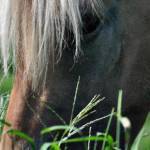Role of Vitamin E in Equine Nerve and Muscle Health

When you think of vitamin E, do images of green, leafy forage or well-muscled, physically fit horses spring to mind? Or perhaps you picture the opposite—a thin, trembling horses with muscle loss? Vitamin E plays an important role in muscle and nerve function, which likely explains why the nutrient is commonly fed to performance horses.
Vitamin E works in concert with selenium as a powerful antioxidant. Supplementation helps horses with vitamin E-responsive myopathy, which is similar to equine motor neuron disease. According to a recent study*, horses diagnosed with equine neuroaxonal dystrophy (eNAD) also benefit from vitamin E.
Equine neuroaxonal dystrophy occurs spontaneously in horses and is similar to a condition called “ataxia with vitamin E deficiency” in humans. The human disease is caused by a genetic mutation involving the movement of vitamin E in the body. As a result, low levels of vitamin E occur in the blood and cerebrospinal fluid of humans, and the same sign is observed in horses with eNAD. While the genetic mutation responsible for ataxia with vitamin E deficiency in humans is known, the cause for eNAD in horses remains mysterious.
Due to the similarities between the two diseases, researchers from various universities throughout the U.S. began searching for the underlying cause of eNAD. They found that a potent chemical called oxysterol produced in the spinal cord during normal metabolic processes damages certain ion channels, resulting in degeneration of neurons that stimulate muscles.
“When sufficient levels of vitamin E exist in the spinal cord, accumulation of oxysterol is thought to be blocked, highlighting the importance of adequate dietary vitamin E,” noted Kathleen Crandell, Ph.D., an equine nutritionist for Kentucky Equine Research (KER).
Horses should consume approximately 1000 IU of vitamin E daily, of which quality green forage goes a long way to fulfilling, said Crandell. If you are concerned your horse is not receiving adequate levels of vitamin E, due to lack of available forage, for example, consider offering Nano-E, a rapidly bioavailable, water-soluble vitamin E product.
When offering nutritional supplements, do not oversupplement any individual nutrient, including vitamin E. As always, select quality nutritional supplements to ensure the type and amount of supplement being delivered are appropriate and the product is free from contaminants.
Maintaining a relationship with an equine nutritionist is another way to ensure you’re doing all you can for your horse. Do you have a question about horse nutrition? Start a consultation with a KER nutrition advisor now.
*Finno, C.J., M.H. Bordbari, S.J. Valberg, et al. 2016. Transcriptome profiling of equine vitamin E deficient neuroaxonal dystrophy identifies upregulation of liver X receptor target genes. Free Radical Biology & Medicine. 101:261-271.








